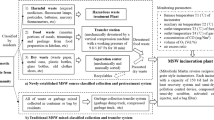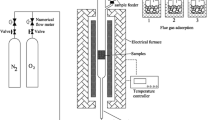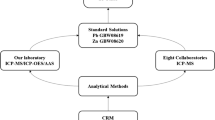Abstract
Municipal solid waste (MSW) is converted to various materials through treatment processes, which in turn distributes potentially toxic elements (PTEs) to recyclable materials. This study is focused on establishing an inventory of combustible wastes with the objective of identifying specific sources of PTEs (B, Cr, Cu, Zn, As, Sb, Ba, and Pb). The combustible wastes were classified into 26 components by the criterion, which can be conveniently identified by the public. Each component of the combustible wastes was ignited at 450 °C, to reduce organic matters and increase the proportional content of the target PTE, before undergoing inductively coupled plasma analysis. The inventory of PTE contents in the waste components was developed from the ash and the ignition loss of each component. The contribution of waste components to the total amount of PTEs was estimated based on the element content and the proportion in waste. Through this series of processes, specific sources of waste components containing PTEs were presented. This work can contribute to the reduction of toxicity of MSW and incineration residues that are to be recycled.



Similar content being viewed by others
References
Sakanakura H, Yui K, Kuramochi H, et al (2016) Concentration and distribution of 56 elements in residues from stoker-type municipal solid waste incineration. 9th International Conference on Combustion, Incineration/Pyrolysis, Emission and Climate Change (9th i-CIPEC), Kyoto, Japan
Wei Y, Li J, Shi D et al (2017) Environmental challenges impeding the composting of biodegradable municipal solid waste: a critical review. Resour Conserv Recycl 122:51–65. https://doi.org/10.1016/j.resconrec.2017.01.024
Iacovidou E, Hahladakis J, Deans I et al (2018) Technical properties of biomass and solid recovered fuel (SRF) co-fired with coal: impact on multi-dimensional resource recovery value. Waste Manag 73:535–545. https://doi.org/10.1016/j.wasman.2017.07.001
Yi S, Jang Y-C (2018) Life cycle assessment of solid refuse fuel production from MSW in Korea. J Mater Cycles Waste Manag 20:19–42
Keulen A, van Zomeren A, Harpe P et al (2016) High performance of treated and washed MSWI bottom ash granulates as natural aggregate replacement within earth-moist concrete. Waste Manag 49:83–95
Joseph MA, Snellings R, Van den Heede P et al (2018) The use of municipal solid waste incineration Ash in various building materials: a Belgian point of view. Mater. 11:141
Sakita S, Nishimura K (2016) Physical containment of municipal solid waste incineration bottom ash by accelerated carbonation. J Mater Cycles Waste Manag 18:687–694. https://doi.org/10.1007/s10163-015-0369-8
Holm O, Wollik E, Johanna Bley T (2018) Recovery of copper from small grain size fractions of municipal solid waste incineration bottom ash by means of density separation. Int J Sustain Eng 11:250–260
Syc M, Simon F-G, Biganzoli L et al (2018) Resource recovery from incineration bottom ash: Basics, concepts, principles. In: Holm O, Thome-Kozmiensky E (eds) Removal, treatment and utilisation of waste incineration bottom ash. Thomé-Kozmiensky Verlag GmbH, Neuruppin, pp 1–10
Yang N, Damgaard A, Scheutz C et al (2018) A comparison of chemical MSW compositional data between China and Denmark. J Environ Sci 74:1–10
Areeprasert C, Kaharn J, Inseemeesak B et al (2018) A comparative study on characteristic of locally source-separated and mixed MSW in Bangkok with possibility of material recycling. J Mater Cycles Waste Manag 20:302–313. https://doi.org/10.1007/s10163-017-0583-7
Jung CH, Matsuto T, Tanaka N, Okada T (2004) Metal distribution in incineration residues of municipal solid waste (MSW) in Japan. Waste Manag 24:381–391. https://doi.org/10.1016/S0956-053X(03)00137-5
Helsen L, Bosmans A (2010) Waste-to-Energy through thermochemical processes: matching waste with process. In: Proceedings of the 1st International Academic Symposium on Enhanced Landfill Mining. Haletra; Houthalen-Helchteren, pp 133–180
Ménard Y, Asthana A, Patisson F et al (2006) Thermodynamic study of heavy metals behaviour during municipal waste incineration. Process Saf Environ Prot 84:290–296
Riber C, Fredriksen GS, Christensen TH (2005) Heavy metal content of combustible municipal solid waste in Denmark. Waste Manag Res 23:126–132. https://doi.org/10.1177/0734242X05051195
Morf LS, Gloor R, Haag O et al (2013) Precious metals and rare earth elements in municipal solid waste—sources and fate in a Swiss incineration plant. Waste Manag 33:634–644. https://doi.org/10.1016/j.wasman.2012.09.010
Belevi H, Langmeier M (2000) Factors determining the element behavior in municipal solid waste incinerators. 2. Laboratory experiments. Environ Sci Technol 34:2507–2512
Astrup T, Riber C, Pedersen AJ (2011) Incinerator performance: effects of changes in waste input and furnace operation on air emissions and residues. Waste Manag Res 29:S57–S68. https://doi.org/10.1177/0734242X11419893
Law SL, Gordon GE (1979) Sources of metals in municipal incinerator emissions. Environ Sci Technol 13:432–438
Zhang H, He P-J, Shao L-M (2008) Flow analysis of heavy metals in MSW incinerators for investigating contamination of hazardous components. Environ Sci Technol 42:6211–6217. https://doi.org/10.1021/es800548w
Bode P, De Bruin M, Aalbers TG, Meyer PJ (1990) Plastics from household waste as a source of heavy metal pollution. In: Zeisler R, Guinn VP (eds) Nuclear analytical methods in the life sciences. Humana Press, Totowa, pp 377–383
Naghii MR, Wall PM, Samman S (1996) The boron content of selected foods and the estimation of its daily intake among free-living subjects. J Am Coll Nutr 15:614–619. https://doi.org/10.1080/07315724.1996.10718638
Garcı́a AJ, Esteban MB, Márquez MC, Ramos P (2005) Biodegradable municipal solid waste: characterization and potential use as animal feedstuffs. Waste Manag 25:780–787. https://doi.org/10.1016/j.wasman.2005.01.006
Long Y-Y, Shen D-S, Wang H-T et al (2011) Heavy metal source analysis in municipal solid waste (MSW): case study on Cu and Zn. J Hazard Mater 186:1082–1087. https://doi.org/10.1016/j.jhazmat.2010.11.106
Nakamura K, Kinoshita S, Takatsuki H (1996) The origin and behavior of lead, cadmium and antimony in MSW incinerator. Waste Manag 16:509–517
Hasselriis F, Licata A (1996) Analysis of heavy metal emission data from municipal waste combustion. J Hazard Mater 47:77–102. https://doi.org/10.1016/0304-3894(95)00107-7
Sakanakura H, Back S, Naruoka T (2019) Contribution of Each Combustible Waste to the Element Content of MSW Incineration Residue. IOP Conf Ser Earth Environ Sci 265:12003. https://doi.org/10.1088/1755-1315/265/1/012003
MOEJ (2018) Instruction on guidance for general waste disposal (in Japanese)
Heiri O, Lotter AF, Lemcke G (2001) Loss on ignition as a method for estimating organic and carbonate content in sediments: reproducibility and comparability of results. J Paleolimnol 25:101–110
Matthiessen MK, Larney FJ, Brent Selinger L, Olson AF (2005) Influence of loss-on-ignition temperature and heating time on ash content of compost and manure. Commun Soil Sci Plant Anal 36:2561–2573
Donkin MJ (1991) Loss-on-ignition as an estimator of soil organic carbon in a-horizon forestry soils. Commun Soil Sci Plant Anal 22:233–241. https://doi.org/10.1080/00103629109368411
Sun CL, Koziński JA (2000) Ignition behaviour of pulp and paper combustible wastes. Fuel 79:1587–1593
Yesiller N, Hanson JL, Cox JT, Noce DE (2014) Determination of specific gravity of municipal solid waste. Waste Manag 34:848–858
Huber F, Blasenbauer D, Aschenbrenner P, Fellner J (2019) Chemical composition and leachability of differently sized material fractions of municipal solid waste incineration bottom ash. Waste Manag 95:593–603
Quina MJ, Bordado JC, Quinta-Ferreira RM (2008) Treatment and use of air pollution control residues from MSW incineration: an overview. Waste Manag 28:2097–2121
Oguchi M, Sakanakura H, Terazono A, Takigami H (2012) Fate of metals contained in waste electrical and electronic equipment in a municipal waste treatment process. Waste Manag 32:96–103. https://doi.org/10.1016/J.WASMAN.2011.09.012
Kida A, Miyazaki T, Kuramochi H (2011) Analytical methods for elements including precious metals and rare metals in electric and electronic products. 22:19–27. https://doi.org/10.3985/mcwmr.22.19
Korkmaz A, Yanik J, Brebu M, Vasile C (2009) Pyrolysis of the tetra pak. Waste Manag 29:2836–2841. https://doi.org/10.1016/j.wasman.2009.07.008
Czajczyńska D, Anguilano L, Ghazal H et al (2017) Potential of pyrolysis processes in the waste management sector. Therm Sci Eng Prog 3:171–197
Blevins DG, Lukaszewski KM (1994) Proposed physiologic functions of boron in plants pertinent to animal and human metabolism. Environ Health Perspect 102:31–33
Martens DC, Westermann DT (1991) Fertilizer application for correcting micronutrient deficiencies. Micronutr Agric. 4:549–592
Abat M, Degryse F, Baird R, McLaughlin MJ (2015) Boron phosphates (BPO4) as a seedling-safe boron fertilizer source. Plant Soil 391:153–160. https://doi.org/10.1007/s11104-015-2424-6
Fiume MM, Bergfeld WF, Belsito DV et al (2015) Safety assessment of Boron Nitride as used in cosmetics. Int J Toxicol 34:53S–60S. https://doi.org/10.1177/1091581815617793
Wilkie CA, Morgan AB (2009) Fire Retardancy of Polymeric Materials, 2nd edn. CRC Press, Boca Raton
Shahid M, Shamshad S, Rafiq M et al (2017) Chromium speciation, bioavailability, uptake, toxicity and detoxification in soil-plant system: a review. Chemosphere 178:513–533
Allam OG (2011) Improving functional characteristics of wool and some synthetic fibres. Open J Org Polym Mater 3:8–19
Madhav S, Ahamad A, Singh P, Mishra PK (2018) A review of textile industry: wet processing, environmental impacts, and effluent treatment methods. Environ Qual Manag 27:31–41
Sungur Ş, Gülmez F (2015) Determination of metal contents of various fibers used in textile industry by MP-AES. J Spectrosc 2015:1–5. https://doi.org/10.1155/2015/640271
Moezzi A, McDonagh AM, Cortie MB (2012) Zinc oxide particles: synthesis, properties and applications. Chem Eng J 185:1–22
Nzihou A, Stanmore B (2013) The fate of heavy metals during combustion and gasification of contaminated biomass—a brief review. J Hazard Mater 256:56–66
Wang T, Yang Q, Wang Y et al (2020) Arsenic release and transformation in co-combustion of biomass and coal: effect of mineral elements and volatile matter in biomass. Bioresour Technol 297:122388. https://doi.org/10.1016/j.biortech.2019.122388
Hasegawa H, Rahman MA, Matsuda T et al (2009) Effect of eutrophication on the distribution of arsenic species in eutrophic and mesotrophic lakes. Sci Total Environ 407:1418–1425
Tangahu BV, Abdullah S, Rozaimah S, Basri H, Idris M, Anuar N, Mukhlisin M (2011) A review on heavy metals (As, Pb, and Hg) uptake by plants through phytoremediation. Int J Chem Eng 2011:1–31. https://doi.org/10.1155/2011/939161
Abbas G, Murtaza B, Bibi I et al (2018) Arsenic uptake, toxicity, detoxification, and speciation in plants: physiological, biochemical, and molecular aspects. Int J Environ Res Public Health 15:59
Van Oyen A, Kühn S, van Franeker JA, Ortlieb M, Egelkraut-Holtus M (2016) Plastic and restricted heavy metals. In: MICRO Conference fate and impact of microplastics in marine ecosystems, Lanzarote, Spain
Rovira J, Nadal M, Schuhmacher M, Domingo JL (2015) Human exposure to trace elements through the skin by direct contact with clothing: risk assessment. Environ Res 140:308–316
Oskarsson A, Reeves AL (2007) CHAPTER 20 - Barium. In: Third E (ed) Nordberg GF, Fowler BA, Nordberg M, Friberg LTBT-H on the T of M. Academic Press, Burlington, pp 407–414
Kresse R, Baudis U, Jäger P, Riechers HH, Wagner H, Winkler J, Wolf HU (2000) Barium and barium compounds. Wiley, VCH Verlag GmbH & Co. KGaA, Weinheim
Pivnenko K, Eriksson E, Astrup TF (2015) Waste paper for recycling: overview and identification of potentially critical substances. Waste Manag 45:134–142
Masternak-Janus A, Rybaczewska-Błażejowska M (2015) Life cycle analysis of tissue paper manufacturing from virgin pulp or recycled waste paper. Manag Prod Eng Rev 6:47–54
Tucker P, Douglas P, Durrant A, Hursthouse AS (2000) Heavy metal content of newspapers: longitudinal trends. Environ Manag Heal 11:47–66
Weisel C, Demak M, Marcus S, Goldstein BD (1991) Soft plastic bread packaging: lead content and reuse by families. Am J Public Health 81:756–758
European Union (1994) European Parliament and Council Directive 94/62/EC of 20 December 1994 on packaging and packaging waste
Helsen L, Van den Bulck E (2005) Review of disposal technologies for chromated copper arsenate (CCA) treated wood waste, with detailed analyses of thermochemical conversion processes. Environ Pollut 134:301–314. https://doi.org/10.1016/j.envpol.2004.07.025
Augustsson A, Sörme L, Karlsson A, Amneklev J (2017) Persistent Hazardous Waste and the Quest Toward a Circular Economy: the Example of Arsenic in Chromated Copper Arsenate-Treated Wood. J Ind Ecol 21:689–699
Hata T, Bronsveld P, Kakitani T, Meier D, Imamura Y (2004) Environmental impact of CCA-treated wood in Japan. In: Environmental impacts of preservative-treated wood, Orlando, USA
Kartal SN, Imamura Y (2005) Removal of copper, chromium, and arsenic from CCA-treated wood onto chitin and chitosan. Bioresour Technol 96:389–392. https://doi.org/10.1016/j.biortech.2004.03.004
Clausen C (2004) Improving the two-step remediation process for CCA-treated wood: Part I. Evaluating oxalic acid extraction. Waste Manag 24:401–405. https://doi.org/10.1016/j.wasman.2003.11.008
Nico PS, Fendorf SE, Lowney YW et al (2004) Chemical structure of arsenic and chromium in CCA-treated wood: implications of environmental weathering. Environ Sci Technol 38:5253–5260
Nasrullah M, Vainikka P, Hannula J et al (2015) Mass, energy and material balances of SRF production process. Part 3: solid recovered fuel produced from municipal solid waste. Waste Manag Res 33:146–156. https://doi.org/10.1177/0734242X14563375
Rotter VS, Kost T, Winkler J, Bilitewski B (2004) Material flow analysis of RDF-production processes. Waste Manag 24:1005–1021. https://doi.org/10.1016/j.wasman.2004.07.015
International Solid Waste Association (2015) Bottom ash from WTE plants: metal recovery and utilization. ISWA Report
Šyc M, Simon FG, Hykš J et al (2020) Metal recovery from incineration bottom ash: state-of-the-art and recent developments. J Hazard Mater 393:122433. https://doi.org/10.1016/j.jhazmat.2020.122433
Acknowledgements
This study is supported by the Environmental Research and Technology Development Fund (3-1804) of the Environmental Restoration and Conservation Agency and Japan Waste Research Foundation.
Author information
Authors and Affiliations
Contributions
Seungki Back: Writing original draft; Methodology; Data curation and validation; Visualization; Review and editing of the manuscript; Supervision. Hirofumi Sakanakura: Conceptualization; Data validation; Resources; Review and editing of the manuscript.
Corresponding author
Additional information
Publisher's Note
Springer Nature remains neutral with regard to jurisdictional claims in published maps and institutional affiliations.
Electronic supplementary material
Below is the link to the electronic supplementary material.
Rights and permissions
About this article
Cite this article
Back, S., Sakanakura, H. Inventory of twenty-six combustible wastes as sources of potentially toxic elements: B, Cr, Cu, Zn, As, Sb, Ba, and Pb. J Mater Cycles Waste Manag 23, 664–675 (2021). https://doi.org/10.1007/s10163-020-01155-7
Received:
Accepted:
Published:
Issue Date:
DOI: https://doi.org/10.1007/s10163-020-01155-7




